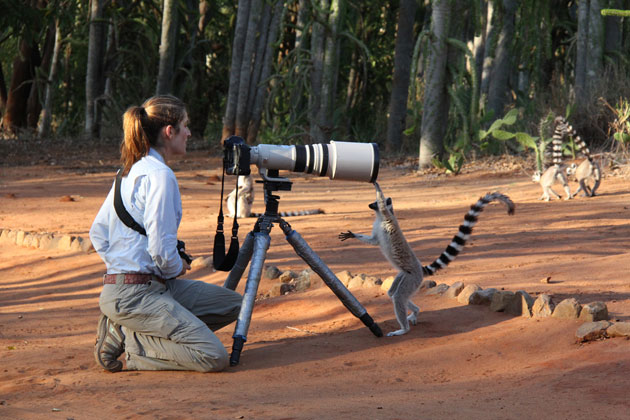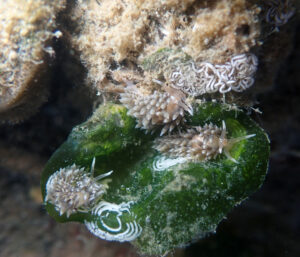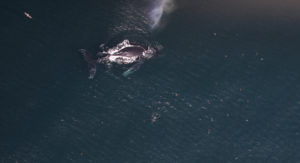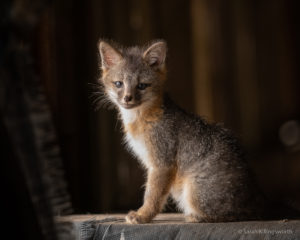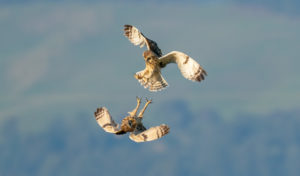Marin-based wildlife photographer Suzi Eszterhas loves talking about photos, loves looking at photos, and loves taking photos, but when it comes to analyzing her career behind the camera, “photography,” she says, “comes second.”
“Knowing the animal, what they might do next, is absolutely critical,” she says. “The animal behavior is the most important part of what I do.”
They tell writers to write what they know; Eszterhas has the same advice for photographers. At least for a while, she says, set aside the camera and really get to know your subject. Find that thing you love, park yourself at its door, and watch.
“Finding one subject I think is a really great way to create more powerful imagery than to just photograph anything you see,” she says. “And also a way to really potentially provide some very unique imagery as well.”
In her case, this has meant spending months just observing animals — getting to know their habits, getting the animals to know her habits — before ever taking a shot. In her first big adventure, photographing cheetahs in the Masai Mara, she spent two years living in a bush camp and working with the same family group. She subsequently spent five months outside the same jackal den, and a year photographing the same tiger family.
Eszterhas has written and photographed a series of wildlife books for children that follow animals from infancy to adulthood, had her work featured on the cover of Time, and is the jury chair of the California Academy of Science’s inaugural Big Picture: Natural World Photography Competition. She will lecture about the rare animals she’s seen and her own adventures in wildlife photography on Wednesday night in the African Hall at the Academy.
“I talk about wildlife behavior more than I talk about photography,” she says. “I love photography, and I love looking at imagery, but there comes to be a point where the F-stop conversation is really dull and boring.”
Important addendum, though: the F-stop matters. For an image to catch her attention in the Academy’s competition, Eszterhas says, it has to be technically flawless.
“All those technical more mundane parts of it, the exposure, the focus, all need to be right on,” she says.
That’s the starting point. Pass that bar and then the judges are looking for the exceptional: behavior, light, composition.
“When you’re looking at contest imagery, you’re looking at things you haven’t seen before, or looking at something you see all the time, like a mallard duck, in a way you haven’t seen it before,” she says. “It doesn’t have to be cutting edge; it could be just a stunning, beautiful, classical portrait. But it has to be a real eye-opening image.”
Eszterhas grew up in San Rafael watching the birds in her backyard. She spends much of the year abroad, and has air travel down to a science (“It’s pathetic to feel homey on an airplane,” she says, “but we get our routines down.”), but still lives in Marin.
After almost a decade of photographing everywhere except California, she was given an assignment to photograph sea otters for the Smithsonian a few years ago. The otters helped connect her back to her roots.
“That was a real nice turning point, because it made me rediscover the animals I’d been photographing when I was younger, but also rediscovered how, when you travel you appreciate your home more,” she says. “I constantly see how lucky I am to live where I’m living.”
Part of her advice for aspiring photographers now is to travel, both to draw inspiration from the world’s wildlife and to better appreciate the wildlife at home.
But the bigger picture remains the same: whether it’s in Africa or California, know your animal first.
“People aren’t going to find an elephant seal as charismatic as a tiger,” she says. “But if you do, if you’re passionate, just spend a lot of time with that subject. Spend time with them when they’re doing something unique or interesting. An elephant seal on a rock is not that interesting. Two elephant seals fighting, during the pupping season, all up and down this coast, you have isolated beautiful secluded beaches — that kind of behavior is absolutely stunning.”
Suzi Eszterhas lectures at the California Academy of Sciences Wednesday, Feb. 26 at 7 p.m. in the African Hall. Tickets are free for members and $12 for non-members and are available online here: http://www.calacademy.org/events/lectures/
The Big Picture: Natural World Photography Competition is open for submissions until March 31. The grand prize is $5,000 as well as $2,000 in camera equipment and a featured exhibit in the Academy. More details can be found here: http://bigpicturecompetition.org/

